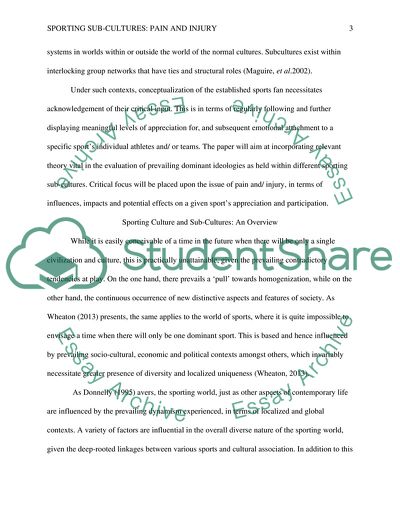Cite this document
(Sporting Sub-Cultures - Pain and Injury Essay Example | Topics and Well Written Essays - 1750 words, n.d.)
Sporting Sub-Cultures - Pain and Injury Essay Example | Topics and Well Written Essays - 1750 words. https://studentshare.org/culture/1849729-2incorporating-relevant-theory-explain-what-is-meant-by-the-term-subculture-and-evaluate-dominant-ideologies-held-within-sporting-subcultures-in-relation-to-one-or-more-of-the-following-paininjury-risk-drugs
Sporting Sub-Cultures - Pain and Injury Essay Example | Topics and Well Written Essays - 1750 words. https://studentshare.org/culture/1849729-2incorporating-relevant-theory-explain-what-is-meant-by-the-term-subculture-and-evaluate-dominant-ideologies-held-within-sporting-subcultures-in-relation-to-one-or-more-of-the-following-paininjury-risk-drugs
(Sporting Sub-Cultures - Pain and Injury Essay Example | Topics and Well Written Essays - 1750 Words)
Sporting Sub-Cultures - Pain and Injury Essay Example | Topics and Well Written Essays - 1750 Words. https://studentshare.org/culture/1849729-2incorporating-relevant-theory-explain-what-is-meant-by-the-term-subculture-and-evaluate-dominant-ideologies-held-within-sporting-subcultures-in-relation-to-one-or-more-of-the-following-paininjury-risk-drugs.
Sporting Sub-Cultures - Pain and Injury Essay Example | Topics and Well Written Essays - 1750 Words. https://studentshare.org/culture/1849729-2incorporating-relevant-theory-explain-what-is-meant-by-the-term-subculture-and-evaluate-dominant-ideologies-held-within-sporting-subcultures-in-relation-to-one-or-more-of-the-following-paininjury-risk-drugs.
“Sporting Sub-Cultures - Pain and Injury Essay Example | Topics and Well Written Essays - 1750 Words”. https://studentshare.org/culture/1849729-2incorporating-relevant-theory-explain-what-is-meant-by-the-term-subculture-and-evaluate-dominant-ideologies-held-within-sporting-subcultures-in-relation-to-one-or-more-of-the-following-paininjury-risk-drugs.


